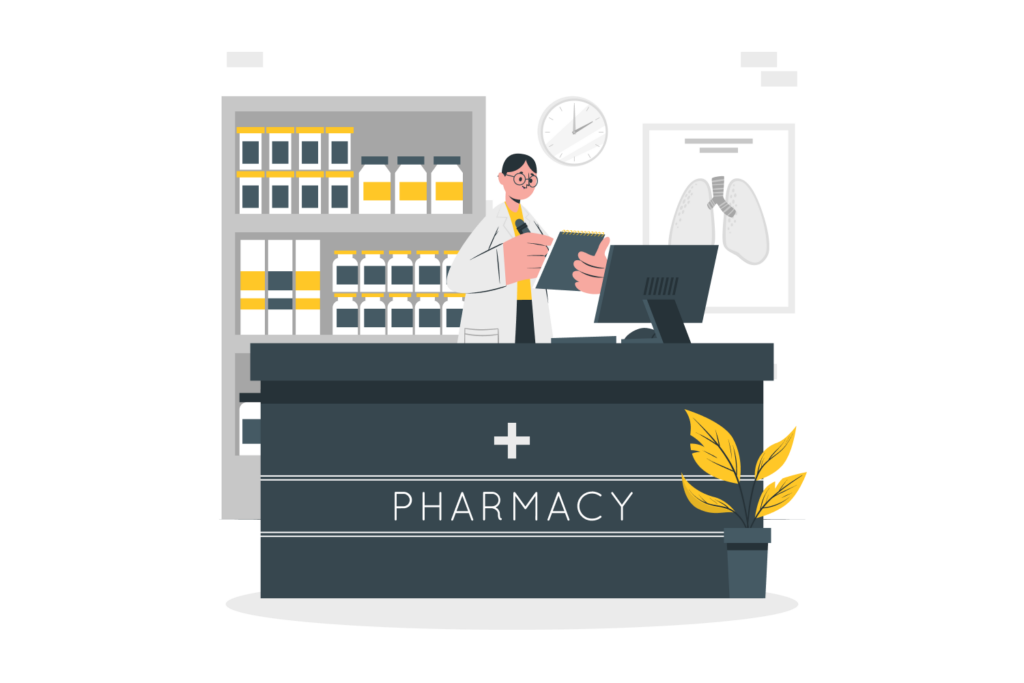This module is designed to help you understand the role of medicines, the risks, side-effects and potential benefits if doctors recommend adding them into your pain care toolbox.
Learning more about the safe use of medicines adds another tool to your pain management toolkit, as your recovery is better when care is holistic.
The information here should not be used as a stand-alone guide, nor should medicines be used as stand-alone treatment.
Important information before you start
Before you decide to take medicine for pain, have a chat with your doctor or pharmacist.
These health professionals will help you check whether the medicine is safe for you. They do this by considering your health and your other medicines, because some medicines or combinations may be dangerous for you.
Doctors will assess, in discussion with you, whether other treatments would be beneficial, in addition to medicines for pain.
It is important to see your doctor if you have any of these symptoms:
- Chills, sweaty episodes, fevers or raised temperatures
- Unexpected weight loss, weakness of your muscles, or change in urine and bowel habits
- If your mood is lower than usual or you feel anxious or are sleeping poorly
- If your pain is severe
You can use our medical screening tool. This screening tool is designed to assess if you have any symptoms or signs that mean you need to see a doctor. Upon completing the check, you can download your report to your computer, phone, or print it to take to your doctor.
Preparing for a discussion with your doctor about using medicines: helpful tips
Words that can help you in discussions with your doctor or pharmacist about using pain medicines:
- Acute pain – the kind that warns us we are about to get injured (too close to the flames) or that we are injured or unwell (after a cut, bruise, break, acutely swollen joint).
- Analgesia – a fancy word meaning the absence of pain.
- Analgesic – a fancy word for a medicine that is thought to reduce pain intensity. Other common terms are ‘pain killer’ and ‘pain reliever’. If you think of pain as a light, then medicines are like a dimmer control, dialling down sensitivity and pain.
- Chronic pain – also called persisting/persistent or recurrent pain; lasts or comes and goes for more than 3 months (pain that continues after healing or seems to go on and on even when the joints or body look normal). Lots of factors can influence chronic pain. For more info, see making sense of your pain.
- Tolerance refers to your body getting used to taking a medicine or other substance, so that higher doses are needed over time to have the same effect. It’s important to work closely with your doctor to slowly reduce and stop the medicines as this helps to avoid withdrawal symptoms and harm.
- Dependence refers to our physical state or psychological feelings that make us feel like we must continue taking a medicine or other substance.
- Opioids and anticonvulsants such as pregabalin and gabapentin can cause tolerance and dependence. If the doctor recommends you take such medicines, ask that they help you understand and manage the risk of dependence.
Using medicines as part of your care plan – the ‘Big Picture’
Lots of factors can influence your pain, so learning what these factors are for you, means care can be better tailored and focused on you as a whole person. Check out our Pain Management modules for practical tips and info. Medicines are recommended for some young people, some of the time, to help with their pain care.
Medicines are just one part of a broader management plan and are commonly used:
- For a short time to prevent pain (pre-emptive analgesia) – for example, before or during a medical procedure
- For a short period to manage acute (short-lived) pain (e.g., after an operation)
- For a short time to reduce chronic (long-term) pain enough to help you start moving and getting back to activity
- To reduce inflammation in auto-immune and inflammatory conditions which in turn can reduce the experience of pain
Why has my doctor prescribed a mix of medicines?
- Sometimes your doctor may advise a combination of different medicines. This is because different medicines target different places in your body in different ways.
- Combining medicines can mean you need a lower dose of each one, with less risk of side effects while ensuring effective relief of pain.
- Some medicines don’t mix, so it is vital that you tell your doctor and pharmacist about any medicine or substance that you use – this keeps you safe.
"If medicines are recommended, they’re only one part of your care"
There are lots of things that can help with managing your pain other than medicines, or in combination with medicines.
Our making sense of your pain management modules gives you practical tips on what these factors are and how you can manage them as part of your care plan.
If you need help from family and friends, share the helping others help you.
How can I safely use medicines that have been prescribed?
Before you decide to take an over-the-counter medicine for pain, have a chat with your doctor or pharmacist. These health professionals will assess your needs and history, as well as other medications you are on.
If an over-the-counter or prescription medication is recommended by your doctor, it’s good to feel informed, so remember to ask your doctor:
About the balance between benefits and potential harms
How to decide whether you will ‘try out’ a medicine for a short time to help work out this balance
How to stop any medicine that either doesn’t help your pain, or that makes you feel worse
Our 6-step guide to safer use of prescribed pain medicines: use this guide to help you safely use your prescribed medication as part of your pain management plan.
If the medicine causes tolerance or dependence, to avoid withdrawal symptoms and harm, it’s important to gradually reduce and stop with medical advice. If the doctor recommends you take such medicines, ask them to help you understand and manage the risk of dependence.
If you have unused medicines, dispose of them safely through a pharmacy or Return of Expired and Unwanted Medicine. This protects others and the environment.
Remember that medications are only part of the tools used to help support you moving forward with valued life activities and progressing the skills you have learnt in our other Pain Management modules.
If you do get a positive benefit from a medicine, it’s great to use this window of opportunity to gradually increase your fun activities, explore new activities and progress your functional goals. This holistic approach helps to move you forward towards what you want to do.
Safety considerations for medicines you might be recommended
People usually want to know that a medicine works. This is really important when there are potential risks or side effects when taking the medicine.
Some pain medicines might reduce your ability to concentrate, drive, or lower your mood. Sometimes medicines have a good effect on pain because of the specific way they work.
Some of a medicine’s effects will be due to other things like hope and expectations, how you feel at the time and your doctor’s confidence. Non-specific ways that a medicine helps is called its ‘placebo’ effect. Medicines should have more than a placebo effect.
Right now, there are lots of science gaps – or evidence gaps – about the use of pain medications for young people living with musculoskeletal pain conditions:
- What pain medicines work best for young people
- What are the best and safest doses
- How much benefit can you expect
- What are the risks when pain medicines are used over a long time
- There are efforts underway to address this critical area of need: see here and here
Below, we have created a summary of medicines that might be recommended for your care, what they are recommended for, potential risks, side-effects, potential benefits and the bottom line.
This information is provided to ensure you have the right information to discuss safe and appropriate medicines use with your doctor.

Pain medications: types, risks, side-effects and potential benefits
Paracetamol for chronic non-cancer pain in young people
Paracetamol may be recommended for acute pain or fever. Paracetamol might be recommended for short-term use (usually less than two weeks) to help you manage a flare-up of chronic pain.
If you are someone who frequently experiences headaches, seek advice from your doctor as headaches can worsen from paracetamol overuse if consumed more than 14 days per month. Paracetamol is an ingredient in many over-the-counter medicines, so always check the ingredients and don’t double up – check with the pharmacist if you’re uncertain.
Paracetamol is the only analgesic medication classed as safe during pregnancy. All other medicines are not recommended.
- Currently, we are uncertain as to whether paracetamol can provide pain relief for chronic non-cancer pain in young people (including children or adolescents)
- The potential benefits and risks of harm with longer-term use for young people are unclear.
- Evidence from adult studies indicates that paracetamol can be effective, in certain doses, and in certain pain conditions.
The bottom line
Although proven to be safe for healthy people in appropriate and controlled dosages, paracetamol can cause harm if overdosed or overused, including headache, liver failure and death.
Non-steroidal anti-inflammatory drugs (NSAIDs) for chronic non-cancer pain in young people
Non-steroidal anti-inflammatories may be recommended for temporary relief of pain or inflammation. NSAIDs are ingredients in many over-the-counter medicines, so always check the ingredients and don’t double up on this group – check with the pharmacist if you’re uncertain.
NSAIDs might be recommended for short-term use (usually less than two weeks) to help you manage a flare-up of chronic pain. These medications may also be recommended by a Rheumatologist to help control an inflammatory condition. This is helpful if you are waiting for a disease-modifying anti-rheumatic drug (DMARD) to start having an effect.
- Currently, there is not enough evidence about the effectiveness of NSAIDs in any dose for young people with chronic non-cancer pain.
- The potential benefits for young people are unclear.
- Evidence from adult studies indicates that NSAIDs can be effective, in certain doses, and in certain pain conditions.
- It’s unclear whether any one NSAID is safer than another for long-term use in young people.
- Guidelines recommend NSAIDs be consumed with food and used at the lowest effective dose for the shortest possible time to avoid harm.
- If you are someone who frequently experiences headaches, seek advice from your doctor as headaches can worsen from NSAID overuse if consumed more than 14 days per month.
The bottom line
Some potential harms for young people have been reported and the incidence of adverse effects can be quite high especially for older type anti-inflammatories. Adverse effects include minor gut symptoms and headache, with more serious effects including bleeding from the bowel. Taking NSAIDs as directed on the package (i.e. with food for most) can decrease the risk of gut ulcers/symptoms.
Opioid medicines for chronic non-cancer pain in young people
Opioids might be recommended for acute severe pain. They are not recommended for chronic non-cancer pain except in exceptional circumstances.
- Opioids pose a risk of dependence and drug abuse.
- Serious harms increase with higher opioid doses, or when opioids are used in some medication combinations.
- Mixing opioids with benzodiazepines and alcohol is dangerous and can be fatal for young people.
- For more information check this out – High-risk opioid use: 10 things you need to know (nps.org.au).
- Currently, there is no evidence about the effectiveness (either way) of any opioid in any dose for young people with chronic non-cancer pain.
- The safety, potential benefits and risks of harm in treating young people 0-19 years with chronic non-cancer pain are unclear.
The bottom line
Known risks include opioid addiction, overdose and death, sleep apnoea (breathing pauses), sexual and hormone dysregulation, driving impairment, nausea and constipation. The risk of serious harm increases with opioid misuse, higher opioid doses, or when opioids are used in some medication combinations.
On average, more than 1 Australian dies every day due to harm from prescription opioids.
This short clip shows how opioids may work in the short-term, and explains the risks and potential side-effects of longer-term use.
Antidepressant medicines for chronic non-cancer pain in young people
Antidepressant medication may be used to target pain rather than mood if you experience pain due to a problem in the nerves, spinal cord and/or areas of the brain – this is known as ‘neuropathic’ or ‘nerve-related’ pain.
Lower doses of antidepressant medicines are used for pain, than would be recommended for mood management. It’s unclear if one type of antidepressant is more effective or safer than another.
The bottom line
It is unclear whether antidepressants provide pain relief for young people aged 0-19 years with chronic non-cancer pain. Known risks include mood disturbance and suicide risk, amongst others.
Antiepileptic medicines for chronic non-cancer pain in young people
Antiepilepsy medication may be used to target pain rather than seizures if you experience pain due to a problem in the nerves, spinal cord and/or areas of the brain – this is known as ‘neuropathic’ or ‘nerve-related’ pain. We currently don’t have evidence to tell us which type of antiepileptic is more effective than another.
In adults, some antiepileptic medicines can be effective in certain chronic pain conditions.
The bottom line
It is unclear whether antiepileptics provide pain relief for young people with chronic non-cancer pain. Yet they are associated with known risks including mood disturbance, suicide risk, and dependence amongst others.
Medicinal cannabis for chronic non-cancer pain in young people
‘Medicinal cannabis’ refers to products that have been standardised so that the ingredients, strength and quality are known. ‘Medicinal cannabis’ may be legal if prescribed by an approved doctor under special circumstances.
- Illicit cannabis (obtained from illegal sources) may be contaminated with microbes, pesticides and heavy metals.
- ‘Medicinal cannabis’ products contain one or more active ingredients extracted from the Cannabis plant. The two commonest active ingredients prescribed are THC (tetrahydrocannabinol) and CBD (cannabidiol). Common forms include oil, flower, spray, capsules, tablets or wafers.
- Side effects can vary between individuals. Medicinal cannabis may not be suitable for people with an active or previous psychotic, mood or anxiety disorder, people who are pregnant or breastfeeding, and those with serious health conditions.
- ‘Medicinal cannabis’ can affect attention and reaction time, reducing your fitness to drive or operate machinery. In WA it’s illegal to drive with THC in your system, regardless of whether it comes from prescribed medicinal cannabis or illicit recreational cannabis. See more here.
- Cannabis may also interact with other medications to cause adverse effects.
- Regular use can be costly, as ‘medicinal cannabis’ is not subsidised by the Pharmaceutical Benefits Scheme (PBS).
- The International Association for the Study of Pain and the Faculty of Pain Medicine (covering Australia and Aotearoa-New Zealand) have weighed up the lack of definite benefits, costs and known harms. They advise people not to use ‘medicinal cannabis’ for chronic non-cancer pain – see their plain language info sheet here.
The bottom line
It is unclear whether medicinal cannabis provides pain relief for young people with chronic non-cancer pain.
Medicinal cannabis is associated with known harms including impaired driving, impaired breathing function, symptoms of mental illness, and altered brain function.

Want more information?
Finding a health professional team who can support you in your care is important. If you need expert help, please view our further contacts.
Alternatively, painAUSTRALIA includes a directory where you can find a pain specialist near you.
You can also ask your health professionals for their help or their recommendations for clinicians working in pain care.
Related management modules
References
- Eccleston C, Fisher E, Howard RF, et al. Delivering transformative action in paediatric pain: a Lancet Child & Adolescent Health Commission. Lancet Child Adolesc Health 2021; 5(1): 47-87. [PubMed]
- Eccleston C, Fisher E, Cooper TE, et al. Pharmacological interventions for chronic pain in children: an overview of systematic reviews. Pain 2019; 160(8): 1698-707. [PubMed]
- Cochrane Special Collection: Reducing pain in infants, children, and adolescents link
- WHO Guidelines on the Pharmacological Treatment of Persisting Pain in Children with Medical Illnesses [PubMed]
- Hindley G, Beck K, Borgan F, et al. Psychiatric symptoms caused by cannabis constituents: a systematic review and meta-analysis. Lancet Psychiatry. 2020 Apr;7(4):344-353 [PubMed]
